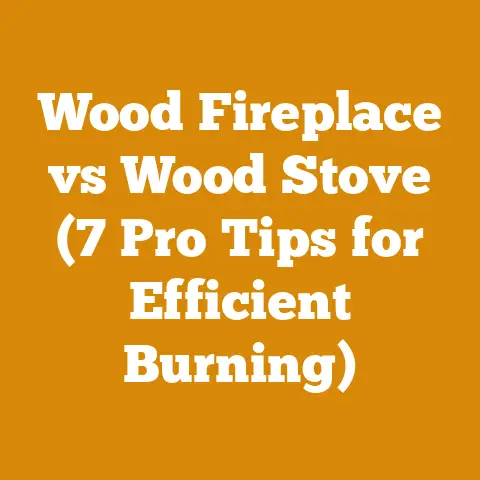Cleaning a Boiler Heat Exchanger (5 Pro Tips for Wood Stove Users)
Cleaning a Boiler Heat Exchanger: 5 Pro Tips for Wood Stove Users
Let’s get straight to it. You want to keep your wood stove running efficiently and safely, and a clean boiler heat exchanger is crucial. Over the years, I’ve seen firsthand the difference a clean heat exchanger can make – from improved heating performance to reduced risk of chimney fires. I’m going to share my top 5 pro tips, gleaned from years of experience, to help you tackle this essential maintenance task.
Why a Clean Heat Exchanger Matters
A boiler heat exchanger, often found in wood stoves with water heating capabilities, is designed to transfer heat from the hot flue gases to the water circulating through your heating system. Over time, creosote and soot build up on the heat exchanger surfaces. This buildup acts as an insulator, reducing the efficiency of heat transfer. This isn’t just about losing some heat; it’s about safety and longevity.
The Consequences of Neglect:
- Reduced Efficiency: A layer of just 1/8 inch of soot can reduce heat transfer by as much as 25%. This means you’re burning more wood to get the same amount of heat.
- Increased Fuel Consumption: Less efficient heat transfer directly translates to higher wood consumption.
- Higher Flue Gas Temperatures: The heat that should be going into your water is instead exiting through your chimney, increasing the risk of creosote ignition and chimney fires.
- Corrosion: Creosote is acidic and can corrode the metal of your heat exchanger over time, leading to costly repairs or replacements.
- Reduced Lifespan: Overheating and corrosion shorten the lifespan of your entire wood stove system.
Takeaway: Regularly cleaning your boiler heat exchanger is not just good practice; it’s essential for safety, efficiency, and the longevity of your wood stove.
Pro Tip 1: Know Your System
Before you even think about picking up a brush, understand your specific wood stove and boiler heat exchanger design. Every model is different, and the cleaning procedure will vary. This is the most important step, because it allows you to prepare for any potential issues.
Understanding Your Manual is Key:
- Locate the Manual: Start by finding the owner’s manual for your wood stove. If you’ve misplaced it, most manufacturers have manuals available online.
- Identify the Heat Exchanger: The manual will clearly identify the location of the heat exchanger within your wood stove.
- Cleaning Instructions: Pay close attention to the manufacturer’s recommended cleaning procedure. They will specify the types of tools you should use and any precautions you should take.
- Diagrams and Schematics: Study the diagrams and schematics in the manual. This will help you visualize the heat exchanger’s construction and how it’s accessed for cleaning.
Different Designs, Different Approaches:
- Water Jackets: Some wood stoves feature water jackets surrounding the firebox. These may require a different cleaning approach compared to stoves with a separate heat exchanger.
- Tube-Style Heat Exchangers: These consist of a series of tubes through which flue gases pass. Cleaning usually involves brushing the inside of the tubes.
- Plate-Style Heat Exchangers: These use a series of plates to transfer heat. Cleaning typically involves accessing the plates and brushing them individually.
Personal Story: I once helped a friend clean his wood stove, and we nearly damaged the heat exchanger because we assumed it was the same design as mine. Luckily, we stopped and consulted the manual before causing any serious harm. This experience taught me the importance of knowing your specific system.
Actionable Steps:
- Locate your wood stove’s owner’s manual.
- Carefully read the manual and identify the location and design of the heat exchanger.
- Understand the manufacturer’s recommended cleaning procedure.
- If you’re unsure about anything, contact the manufacturer or a qualified wood stove technician.
Takeaway: Understanding your specific system is the foundation for a successful and safe cleaning process.
Pro Tip 2: Gather the Right Tools
Having the right tools makes the job significantly easier and more effective. Using the wrong tools can damage the heat exchanger or leave it inadequately cleaned.
Essential Tools:
- Wire Brushes: Invest in a set of wire brushes specifically designed for cleaning wood stoves and chimneys. Different sizes and shapes are needed to reach all areas of the heat exchanger. I use a variety of brushes, including round brushes for cleaning tubes and flat brushes for cleaning surfaces.
- Chimney Sweep Rods: These are flexible rods that can be connected together to reach deep into the heat exchanger.
- Vacuum Cleaner with HEPA Filter: A vacuum cleaner with a HEPA filter is essential for removing the dislodged creosote and soot. Avoid using a regular vacuum cleaner, as it can release fine particles into the air.
- Scraper: A scraper can be used to remove stubborn deposits of creosote. Choose a scraper made of a soft metal, such as brass, to avoid damaging the heat exchanger.
- Inspection Mirror: An inspection mirror is helpful for visually inspecting the heat exchanger after cleaning.
- Flashlight or Headlamp: Good lighting is essential for seeing what you’re doing.
- Safety Glasses and Dust Mask: Protect your eyes and lungs from dust and debris.
- Gloves: Wear gloves to protect your hands from dirt and creosote.
Tool Selection Considerations:
- Material: Choose brushes with bristles made of steel or stainless steel for durability.
- Size: Select brushes that are appropriately sized for the specific areas you need to clean.
- Flexibility: Chimney sweep rods should be flexible enough to navigate bends in the heat exchanger.
- Attachment: Ensure that the brushes and scraper can be securely attached to the chimney sweep rods.
My Favorite Tools:
- Sooteater Rotary Chimney Cleaning System: This system uses a flexible rod with a rotating brush head to clean chimneys and heat exchangers quickly and effectively.
- Gardus RotoClean Rotary Chimney Cleaning System: Another excellent rotary cleaning system that is easy to use and produces great results.
- Magno-Flex Brush: This brush has a flexible shaft that allows you to reach difficult areas.
Cost-Effective Alternatives:
If you’re on a tight budget, you can create your own cleaning tools using readily available materials. For example, you can attach a wire brush to a length of PVC pipe to create a makeshift chimney sweep rod. However, I recommend investing in quality tools for long-term use and effectiveness.
Actionable Steps:
- Review your wood stove’s manual to determine the specific tools required for cleaning the heat exchanger.
- Gather the essential tools listed above.
- Consider investing in specialized tools like a rotary cleaning system for improved efficiency.
- Ensure that all tools are in good working condition before starting the cleaning process.
Takeaway: Having the right tools on hand will make the cleaning process easier, faster, and more effective.
Pro Tip 3: The Cleaning Process – Step-by-Step
Now, let’s get down to the nitty-gritty. The cleaning process will vary depending on your specific wood stove and heat exchanger design, but here’s a general step-by-step guide:
Preparation is Key:
- Safety First: Ensure the wood stove is completely cool before starting the cleaning process. This is crucial to avoid burns.
- Protect Your Surroundings: Cover the area around the wood stove with drop cloths or plastic sheeting to protect your floors and furniture from dust and debris.
- Open Dampers: Open the stove damper completely to provide maximum airflow during cleaning.
- Access the Heat Exchanger: Consult your wood stove’s manual to determine how to access the heat exchanger. This may involve removing panels or grates.
Cleaning the Heat Exchanger:
- Brush Thoroughly: Use the appropriate wire brushes to scrub the surfaces of the heat exchanger. Work systematically, ensuring that you reach all areas. Apply firm pressure, but avoid excessive force that could damage the heat exchanger.
- Use Chimney Sweep Rods: If your heat exchanger has tubes or narrow passages, use chimney sweep rods with attached brushes to clean them. Connect the rods together as needed to reach the full length of the tubes.
- Scrape Stubborn Deposits: Use a scraper to remove any stubborn deposits of creosote that cannot be removed with brushing. Be careful not to scratch or damage the heat exchanger surface.
- Vacuum the Debris: Use a vacuum cleaner with a HEPA filter to remove the dislodged creosote and soot. Vacuum all areas of the heat exchanger and the surrounding firebox.
- Inspect Carefully: Use an inspection mirror and flashlight to carefully inspect the heat exchanger after cleaning. Make sure that all surfaces are clean and free of debris.
- Reassemble: Once you’re satisfied with the cleaning, reassemble the wood stove according to the manufacturer’s instructions.
Specific Cleaning Techniques:
- Tube-Style Heat Exchangers: Insert a round wire brush into each tube and rotate it to remove creosote. Use chimney sweep rods to reach the full length of the tubes.
- Plate-Style Heat Exchangers: Use a flat wire brush to clean the surfaces of each plate. Pay close attention to the edges and corners, where creosote tends to accumulate.
- Water Jackets: Use a combination of brushes and scrapers to clean the interior surfaces of the water jacket. Be careful not to damage any of the internal components.
Personal Story: I remember one time when I thought I had thoroughly cleaned a heat exchanger, but after inspecting it with a mirror, I found a significant amount of creosote hidden in a corner. This taught me the importance of careful inspection after cleaning.
Actionable Steps:
- Follow the step-by-step guide above to clean your wood stove’s heat exchanger.
- Use the appropriate tools and techniques for your specific heat exchanger design.
- Pay close attention to detail and ensure that all surfaces are thoroughly cleaned.
- Inspect the heat exchanger carefully after cleaning to ensure that no debris remains.
Takeaway: A systematic and thorough cleaning process is essential for maintaining the efficiency and safety of your wood stove.
Pro Tip 4: Creosote Prevention – The Best Defense
Cleaning is essential, but preventing creosote buildup in the first place is even better. By implementing preventative measures, you can reduce the frequency of cleaning and extend the lifespan of your wood stove.
Understanding Creosote Formation:
Creosote is formed when unburned wood particles and gases condense in the chimney or heat exchanger. This condensation is most likely to occur when flue gas temperatures are low. Several factors contribute to low flue gas temperatures:
- Burning Wet Wood: Wet wood requires more energy to burn, which lowers the flue gas temperature.
- Restricted Airflow: Insufficient airflow leads to incomplete combustion, resulting in more unburned particles and gases.
- Oversized Chimney: An oversized chimney allows flue gases to cool too quickly, promoting condensation.
- Slow, Smoldering Fires: Slow, smoldering fires produce more smoke and unburned particles than hot, clean-burning fires.
Preventative Measures:
- Burn Dry Wood: Use only seasoned wood with a moisture content of 20% or less. This ensures efficient combustion and reduces the amount of unburned particles and gases. I always recommend using a moisture meter to check the moisture content of your wood.
- Maintain Proper Airflow: Ensure that your wood stove has adequate airflow to support complete combustion. Avoid restricting the air intake too much.
- Burn Hot Fires: Burn hot, clean-burning fires to minimize the production of smoke and unburned particles. Avoid slow, smoldering fires.
- Insulate Your Chimney: Insulating your chimney helps to maintain higher flue gas temperatures, reducing the risk of condensation.
- Proper Chimney Sizing: Ensure that your chimney is properly sized for your wood stove. An oversized chimney can lead to excessive cooling of flue gases.
- Regular Chimney Inspections: Have your chimney inspected annually by a qualified chimney sweep. They can identify potential problems and recommend solutions.
Wood Moisture Content:
- Ideal Moisture Content: 15-20%
- Acceptable Moisture Content: 20-25%
- Unacceptable Moisture Content: Above 25%
Personal Story: I once burned a load of wood that I thought was dry, but it turned out to have a high moisture content. The result was a significant buildup of creosote in my chimney and heat exchanger. This experience taught me the importance of always checking the moisture content of my wood before burning it.
Actionable Steps:
- Burn only seasoned wood with a moisture content of 20% or less.
- Maintain proper airflow in your wood stove.
- Burn hot, clean-burning fires.
- Insulate your chimney if necessary.
- Ensure that your chimney is properly sized for your wood stove.
- Have your chimney inspected annually by a qualified chimney sweep.
Takeaway: Preventing creosote buildup is the most effective way to maintain the efficiency and safety of your wood stove.
Pro Tip 5: Regular Maintenance Schedule
Cleaning your boiler heat exchanger shouldn’t be a one-time event. Establishing a regular maintenance schedule will ensure that your wood stove operates efficiently and safely for years to come.
Frequency of Cleaning:
The frequency of cleaning will depend on several factors, including:
- Type of Wood Burned: Softwoods tend to produce more creosote than hardwoods.
- Burning Habits: Burning wet wood or slow, smoldering fires will increase creosote buildup.
- Wood Stove Usage: The more you use your wood stove, the more frequently you will need to clean it.
General Guidelines:
- Inspect Monthly: Inspect your chimney and heat exchanger monthly for signs of creosote buildup.
- Clean Annually: Clean your chimney and heat exchanger at least once a year, preferably before the start of the heating season.
- Clean More Frequently if Necessary: If you notice excessive creosote buildup, clean your chimney and heat exchanger more frequently.
Maintenance Checklist:
- Inspect Chimney: Check for cracks, damage, and excessive creosote buildup.
- Inspect Heat Exchanger: Check for creosote buildup, corrosion, and damage.
- Clean Chimney: Sweep the chimney to remove creosote and debris.
- Clean Heat Exchanger: Clean the heat exchanger according to the manufacturer’s instructions.
- Inspect Gaskets and Seals: Check the gaskets and seals on your wood stove door and chimney connections. Replace them if they are damaged or worn.
- Inspect Air Vents: Ensure that the air vents are clean and unobstructed.
- Check Damper: Make sure the damper is functioning properly.
- Test Smoke Detector: Test your smoke detector to ensure that it is working properly.
Record Keeping:
Keep a record of your maintenance activities, including the date of each cleaning, the amount of creosote removed, and any repairs that were made. This will help you track your wood stove’s performance and identify potential problems early on.
Personal Story: I once neglected to clean my chimney for two years, and when I finally got around to it, I was shocked by the amount of creosote that had accumulated. It was a fire hazard waiting to happen. This experience taught me the importance of sticking to a regular maintenance schedule.
Actionable Steps:
- Establish a regular maintenance schedule for your wood stove.
- Inspect your chimney and heat exchanger monthly.
- Clean your chimney and heat exchanger at least once a year.
- Follow the maintenance checklist provided above.
- Keep a record of your maintenance activities.
Takeaway: A regular maintenance schedule is essential for ensuring the long-term efficiency, safety, and reliability of your wood stove.
By following these 5 pro tips, you can keep your boiler heat exchanger clean and your wood stove running efficiently and safely for years to come. Remember, safety and efficiency are paramount when dealing with wood stoves, so don’t hesitate to consult a qualified professional if you have any questions or concerns. Now get out there and get that heat exchanger sparkling!






